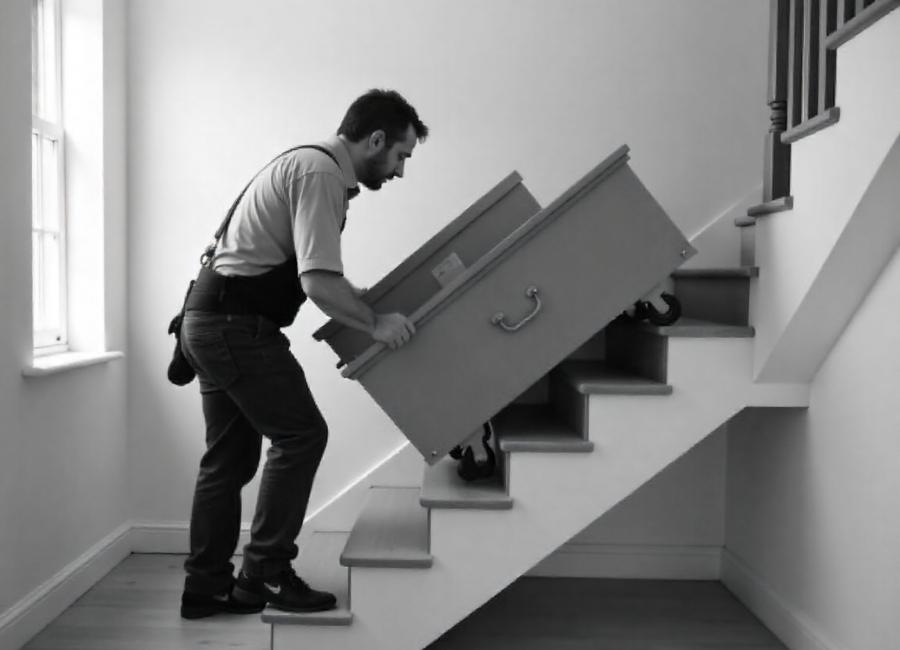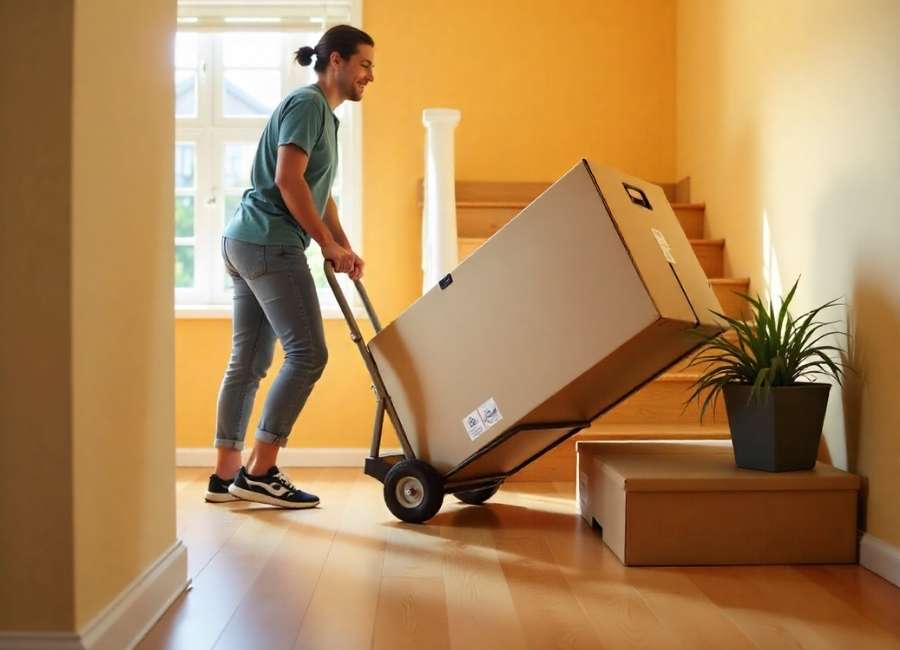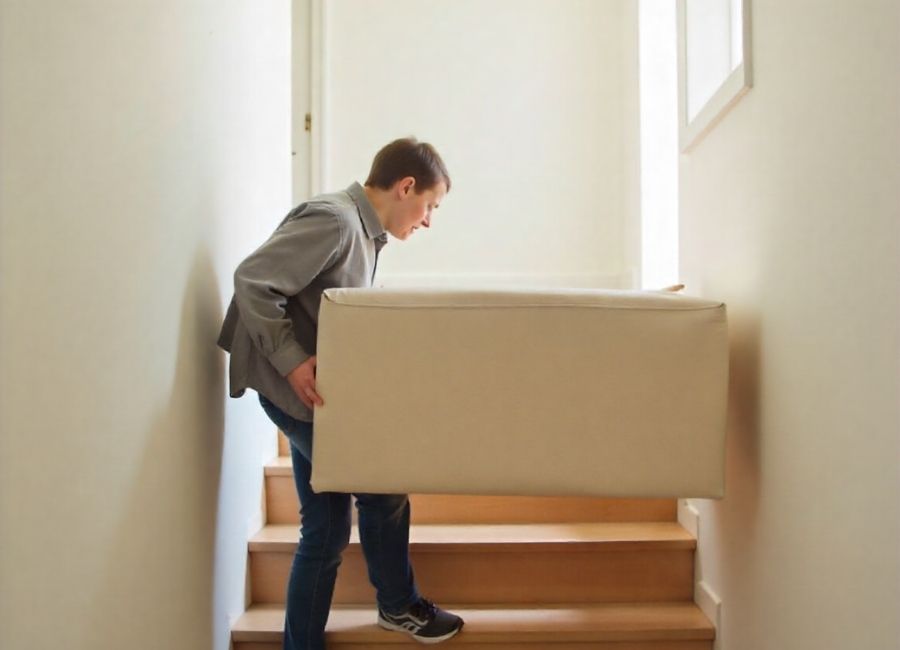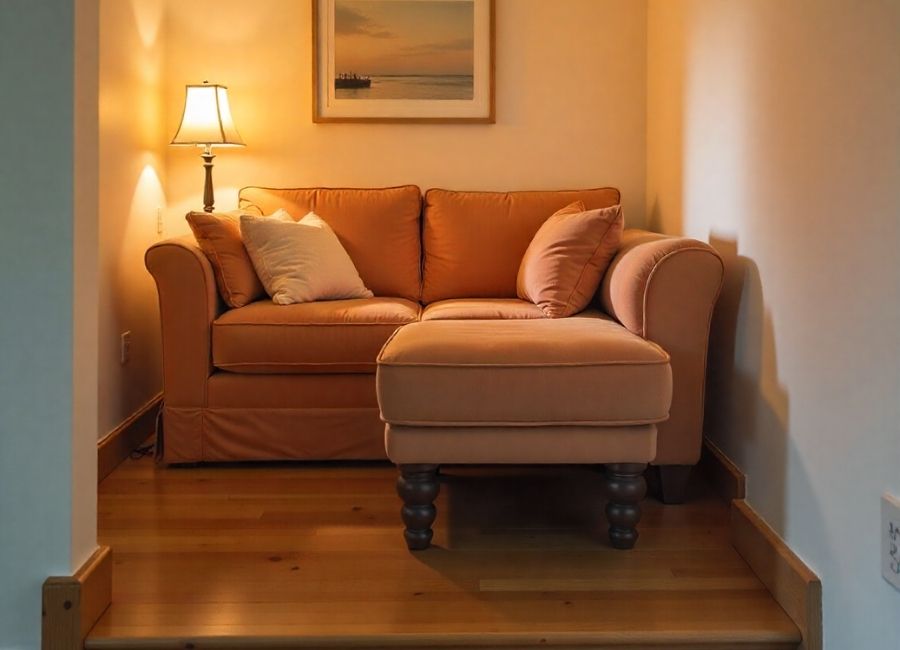Moving day is exciting, but the thought of hauling a heavy couch or a solid oak dresser up a flight of stairs can quickly turn that excitement into dread. It’s not just about the physical effort; it’s about doing it safely. A wrong move can lead to scratched walls, damaged furniture, or worse, a serious injury.
Successfully moving heavy furniture up stairs comes down to having the right strategy, the right equipment, and a little bit of patience. This guide will walk you through the essential steps to make the process as smooth and safe as possible. You’ll learn how to properly prepare your furniture and the path, what equipment to use, and the techniques that professional movers rely on to get the job done without a hitch. By the end, you’ll feel more confident about tackling this challenging part of your move.
Prepare Before You Pivot

Before you even think about lifting that bookcase, a little preparation can save you a lot of trouble. Proper planning is the most critical step in moving heavy items, especially when stairs are involved.
Measure Everything Twice
Start by measuring the piece of furniture you need to move. Note its height, width, and depth. Next, measure the dimensions of your stairwell, including the width of the stairs, the height of the ceiling (especially at the lowest point), and the space available at any landings or turns. This simple step will help you determine if the furniture will fit and assist you in planning your path. There’s nothing worse than getting halfway up a flight of stairs only to realize your sofa won’t make the turn.
Lighten the Load
Your next task is to make the furniture as light as possible. This might seem obvious, but it’s a step people often rush.
- Empty it out: Remove all contents from drawers, cabinets, and shelves. Don’t just move items to one side; take everything out completely.
- Remove detachable parts: Take out any drawers, shelves, and legs. Place them in a separate, labeled bag or box. This not only reduces weight but can also make the furniture less awkward to carry. For items like bed frames, disassemble them as much as you can.
Protect Your Furniture and Your Home
Once the furniture is empty and disassembled, protect its surfaces. Wrap corners and delicate edges with bubble wrap, moving blankets, or old towels, and secure them with packing tape. This prevents scratches and dents to the furniture itself.
Equally important is protecting your home. Cover bannisters and railings with blankets. Lay down cardboard or old rugs on the floor at the top and bottom of the stairs to protect them from scuffs and dirt. Check the walls along the staircase for anything that could be knocked off, like picture frames, and remove them.
Use the Right Tools for the Job

Trying to move heavy furniture up stairs with just your hands is a recipe for disaster. The right equipment makes the task safer, easier, and more efficient. You can rent most of these items from a local moving supply or hardware store.
Furniture Dollies
There are two main types of dollies that are useful for moving:
- Utility Dolly (or Hand Truck): This L-shaped dolly is ideal for taller items, such as bookcases, refrigerators, or filing cabinets. You can slide the base under the item, strap it securely to the dolly’s frame, and then tilt it back to roll. Many utility dollies come with built-in stair climbers—small rotating wheels that make it easier to go up and down steps.
- Furniture Dolly: This is a simple, flat platform with four wheels. It’s ideal for moving large, bulky items like sofas, dressers, or mattresses across flat surfaces to the base of the stairs.
Moving Straps (Forearm Forklift)
Moving straps, also known as lifting straps or a “forearm forklift,” are a game-changer for moving heavy furniture with a partner. (Forearm Forklift: The Ultimate Moving and Lifting Solution, n.d.) These straps use leverage to make the item feel significantly lighter. They loop under the furniture and around your forearms or shoulders, allowing you to lift with your legs and core instead of straining your back. (ShoulderDolly® Moving Straps, 2025) They are particularly effective for items that are too wide or oddly shaped to fit on a dolly.
Moving Blankets and Sliders
- Moving Blankets: These thick, padded blankets are essential. Use them to wrap your furniture to prevent scratches and dents. They can also be used to create a makeshift slide.
- Furniture Sliders: These are small plastic or felt-padded discs you place under the corners of heavy furniture. They allow you to slide items easily across carpet or hardwood floors with minimal effort, which is great for getting your furniture up the staircase. (EZ Moves Furniture Moving System for Carpeted & Hard Floor Surfaces, Move Heavy Furniture Quickly & Easily, As Seen on TV (1 Lifter Tool & 8 Sliders), n.d.)
The Best Techniques for Moving Furniture Upstairs

With your furniture prepped and your equipment ready, it’s time to tackle the stairs. The key here is technique. Slow and steady wins the race.
The High-Low Method
This is the go-to technique for carrying long items, such as sofas, dressers, or mattresses, up stairs with a partner.
- Positioning: One person should be at the bottom of the stairs (the “low” person) and the other at the top (the “high” person). The stronger person should ideally take the lower position, as they will bear more of the weight. (Moving Heavy Furniture Upstairs By Yourself, n.d.)
- Lifting: The person at the bottom lifts the front of the furniture, while the person at the top walks backward up the stairs, guiding the back end. The low person will be holding the item high (above their waist), while the high person holds their end low (around their knees).
- Communication: The person walking backward (at the top) is in charge of steering and should communicate clearly and effectively. They have the best view of the path ahead. Use simple commands like “left,” “right,” “slow,” or “stop.”
Sliding the Furniture
For some heavy but sturdy pieces, sliding can be a safer option than carrying.
- Create a Ramp: Lay a pair of sturdy wooden planks over the stairs to create a smooth ramp. Ensure they are secure and can withstand the weight.
- Use Blankets: Alternatively, you can lay thick moving blankets down the stairs. With a person at the top and bottom to guide it, you can carefully slide the wrapped furniture up the blankets. This method works well for heavy items, such as dressers, but requires careful control to prevent the item from slipping away.
Using a Dolly with Stair Climbers
If you have a utility dolly with stair climbers, this is one of the most effective methods for tall, heavy items.
- Secure the Item: Place the item on the dolly and secure it tightly with straps.
- Ascend the Stairs: One person should be in front, pulling the dolly up one step at a time, while a partner pushes from behind. The stair-climbing wheels will help the dolly roll over the edge of each step. Go slowly and rest as needed.
Safety First, Always
No piece of furniture is worth an injury. Keep these safety rules in mind at all times:
- Lift with Your Legs: Always bend at your knees, not your waist. Keep your back straight and use your powerful leg muscles to lift.
- Wear Proper Gear: Wear closed-toe shoes with a good grip. Gloves can protect your hands and improve your hold on the furniture.
- Clear the Path: Make sure the path is completely clear of tripping hazards, including pets and small children.
- Know Your Limits: If an item feels too heavy, don’t risk it. It’s better to call for more help or hire professional movers.
When to Call the Professionals
While these tips can help you move many heavy items, some situations are best left to the pros. If you’re dealing with exceptionally heavy or valuable items, such as a piano, a grandfather clock, or a solid marble tabletop, hiring professional movers is a wise investment. They have the experience, specialized equipment, and insurance to handle these items safely. (Local Professional Grandfather Clock Movers and Shippers, n.d.) Similarly, if you have a particularly narrow or winding staircase, the expertise of a moving team can be invaluable.
A Smooth Move Upward
Moving heavy furniture up stairs doesn’t have to be the most dreaded part of your move. With careful planning, the right equipment, and proper technique, you can navigate your staircase safely and efficiently. Remember to take your time, communicate with your helpers, and prioritize safety above all else. A little extra effort in preparation will pay off in a smooth, damage-free move, letting you get back to the exciting part—setting up your new home.











